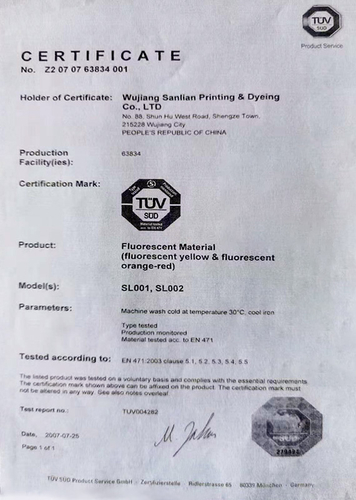SAF Outdoor Cooling Vest: Composition and Technical Principles of SAF Cooling Material
1. Composition of SAF Cooling Material in SAF Outdoor Cooling Vest
The SAF cooling material integrated into the SAF Outdoor Cooling Vest is composed of advanced hydrophilic polymers and specialized compounds designed to maximize evaporative cooling efficiency while maintaining durability and reusability. The key components include:
Hydrophilic Polymer Gels or Crystals: These water-absorbing polymers swell upon contact with water, creating a reservoir for gradual evaporation. They are central to the cooling process by facilitating prolonged moisture release.
Microencapsulated Phase Change Materials (PCMs): Some advanced cooling materials incorporate PCMs, which store and release thermal energy during phase transitions (solid to liquid or vice versa). These materials help regulate temperature fluctuations, ensuring consistent cooling over extended periods.
Polyester Matrix (68%): Provides structural integrity and ensures the material remains durable and lightweight even after repeated use.
Polymer Blend (32%): Likely includes the hydrophilic gel or PCM components responsible for the core cooling functionality.
2. Technical Principle of SAF Cooling Material in SAF Outdoor Cooling Vest
The cooling mechanism of the SAF cooling material in the SAF Outdoor Cooling Vest operates through a combination of evaporative cooling and thermal regulation , as detailed below:
a. Evaporative Cooling Mechanism
When the SAF Outdoor Cooling Vest is soaked in water, the hydrophilic polymer gels or crystals absorb water and expand significantly. This absorption creates a reservoir of moisture within the material.
As the absorbed water gradually evaporates, it draws heat away from the body, mimicking the natural cooling process of perspiration but in a controlled and efficient manner.
The inner lining made of Taslan water-repellent nylon ensures that the absorbed water remains contained within the cooling layer, preventing excessive wetness against the skin and enhancing user comfort.
b. Thermal Regulation via Phase Change Materials (if applicable)
If PCMs are integrated into the SAF cooling material , they function by absorbing excess body heat when the temperature exceeds a specific threshold (typically 28°C–30°C).
During cooler conditions, the stored thermal energy is released, helping to maintain a stable and comfortable temperature range for the wearer.
c. Activation Process
Soaking: The vest is immersed in water for 5–10 seconds, allowing the polymer gels/crystals to absorb sufficient moisture.
Moisture Management: Excess water is gently squeezed out or wrung depending on whether the user prefers a drier or moister feel.
Evaporative Cooling Initiation: Once worn, the absorbed water begins to evaporate, drawing heat away from the body and providing up to 5–10 hours of sustained cooling relief.
3. Key Advantages of SAF Cooling Material in SAF Outdoor Cooling Vest
Extended Cooling Duration: The dual-action mechanism of evaporative cooling and potential PCM technology ensures a long-lasting cooling effect, typically lasting 5–10 hours per soaking session.
Reusability and Durability: The SAF cooling material can be reactivated multiple times by simply soaking it again. Its robust construction ensures minimal degradation in performance even after repeated use.
Lightweight and Comfortable Design: The polymer-based structure adds negligible weight while maintaining breathability, making the SAF Outdoor Cooling Vest ideal for extended wear in demanding environments.
Customizable Moisture Levels: Users can adjust the level of moisture retained in the vest by varying the degree of squeezing post-soaking, offering flexibility based on personal preference and environmental conditions.

 English
English 简体中文
简体中文













 3rd Floor, East Gate, No. 2599 Park Road, Sheng Ze Town, Wu Jiang District, Suzhou City, Jiangsu Province
3rd Floor, East Gate, No. 2599 Park Road, Sheng Ze Town, Wu Jiang District, Suzhou City, Jiangsu Province  +86- 0512-63519080
+86- 0512-63519080
 +86-13584404311
+86-13584404311 